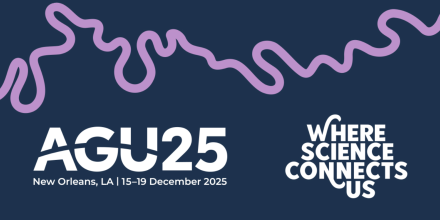US CLIVAR Related Sessions at the Fall 2025 AGU Meeting

The 2025 Fall AGU meeting will take place December 15-19, 2025, in New Orleans, LA. The theme, "Where Science Connects Us," will explore and celebrate the connections shaping the broader Earth science community. Abstract submissions are due Wednesday, July 30.
Climate and Atmosphere
- Advances in Atmospheric Chemistry Driven by Laboratory Studies
- Advances in Decadal Climate Change: Evidence from Air-Sea Interaction, Mechanisms, and Predictability
- Advances in Fundamental Understanding of Atmospheric Convection: From Cloud Microphysics to Large-Scale Organization
- Atmospheric Aerosols and their Interactions with Clouds, Radiation, and Climate
- Atmospheric Rivers: Processes, Impacts, Observations, and Uncertainties
- Boundary Layer Clouds and Earth System Coupling
- Dust in a Changing Climate: From Small-Scale Insights to Large-Scale Understanding
- Mesoscale Air-Sea Interactions: Bridging Fine-Scale Processes to Climate-Relevant Effects
- North Atlantic Paleoclimate: Sedimentary Archives of Climate, Ocean Circulation, and Ice Sheet Interactions
- Prediction and Variability of Earth Rotation Parameters: Influence of Climate and Geophysical Fluids
Ocean and Coasts
- Advances in Understanding Global Meridional Overturning Circulation from Past to Future: Insights from Multiple Approaches
- Atmosphere, Ocean, and Land Processes in the Maritime Continent and Indo-Pacific
- Bathymetry through Time: Advances in Modern Mapping, Paleo-Reconstruction, and Oceanographic Applications
- Bridging Scales to Advance Ocean-Based Carbon Dioxide Removal
- Coastal Hydrology: Observations, Modeling, and Predictions of Surface and Subsurface Processes and Patterns
- Connecting Students and Faculty to Ocean Sciences and Career Pathways through Seagoing Experiences
- Discoveries from the SWOT Mission: Insights into Ocean Dynamics, Marine Gravity, the Cryosphere, Deltas, and Estuaries
- Dynamic Coastlines amidst Changing Sea Level: Advancements in Understanding of Coastal Hazards and Climate Change Impacts
- El Nino-Southern Oscillation and Pantropical Climate Interactions: Mechanisms, Predictability, Impacts, and Projections
- Physical and Biogeochemical Processes on the Warm Antarctic Continental Shelves
- The Surface Water and Ocean Topography (SWOT) Missing: New Frontiers in Hydrology
- Understanding Gulf Ocean Systems: Advances in Improving Ocean Circulation Forecast Skill
- Variability and Predictability of Indo-Pacific Ocean Circulation and Climate
Extremes and Impacts
- Air Pollution Health Risk in a Changing Climate
- Air Pollution Interactions with Extreme Weather and Climate: Mechanisms and Impacts
- Drought Risk in a Changing Climate一Diagnosis, Modeling, and Management
- Early Warning Systems for Infectious Disease Based on Climate and Environmental Variability
- Earth System Predictability Across Timescales for Societal Resilience: Grand Challenges and Recent Advancements
High Latitudes
- Aerosol, Cloud, Precipitation, and Radiation Studies over High Latitude Oceans
- Causes and Consequences of Polar Amplification
- Cyclones in Polar Regions: Dynamics, Impacts, and Future Changes
Observations, Modeling, Data Assimilation, and Machine Learning
- Advances in Cloud and Precipitation Processes: Integrating Observations, Modeling, and Theory
- Advances in Numerical Modeling and Algorithm Development of Dynamical Cores for Global and Regional Weather and Climate Model
- Advancing AI and Machine Learning for Improved Subseasonal-to-Seasonal (S2S) Forecast Skill
- Advancing Precipitation Predictions with Physical Models and Artificial Intelligence
- Advancing Skill in Subseasonal-to-Seasonal (S2S) Prediction
- AI-Driven Innovations in Earth and Atmospheric Sciences
- Bridging the Gap from Climate to Extreme Weather: Theory, Modeling, and Observations
- Confronting Earth System Model Trends with Observations
- Cross-Timescale Interference of Modes of Climate Variability
- Eye Candy or Eye Sore? The Technical and Philosophical Challenges of High-Resolution Climate Data Product Development
- Improved Observational and Modeling Skills to Understand Tropical Cyclone and Winter Storms and their Impacts in the Coastal Zone
- Satellite and In Situ Observations in Support of the Prediction of Coastal Hazard Impacts for Enhancing the Resilience of Coastal Communities
- Strategies for Combining Innovative Monitoring and Modeling Systems in Coastal Environments
- Sustained Observations of the Global-Scale Ocean Interior: Elements of the Global Ocean Observing System
